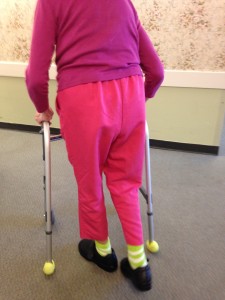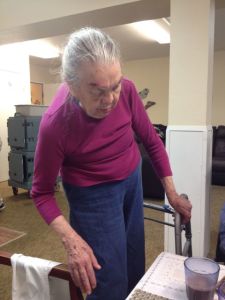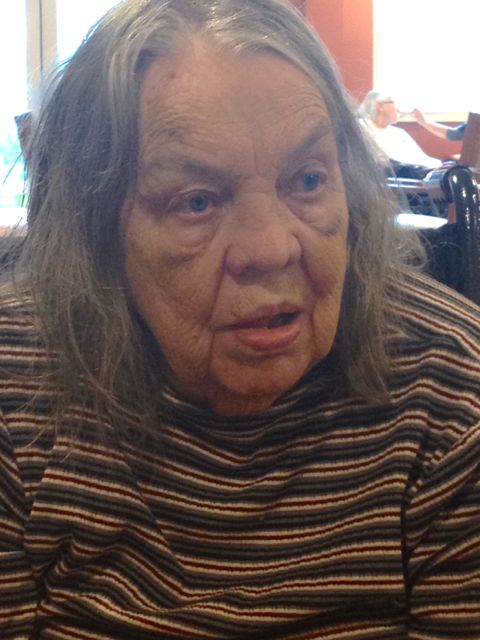
by Diane Masson | Aug 16, 2015
 I asked the same question to four memory care communities that were licensed as assisted living. The responses might surprise you and help you determine where to place your own mom or dad.
I asked the same question to four memory care communities that were licensed as assisted living. The responses might surprise you and help you determine where to place your own mom or dad.
What happens if my mother-in-law wakes up disoriented at 2:00 AM and gets up to find the bathroom? Then she falls…
Memory Care Community A – “When we find her, a med tech would evaluate her. If she hit her head or something major happened, then 911 is called. My husband asked about the med tech training. Is it like an emergency medical technician (EMT) with a minimum of 140 hours of medical training? She said, “No, it is like a CNA (Certified Nursing Assistant). There are specific criteria that they are trained on.”
Does someone go with the dementia resident if they go out 911? No!
Diane’s opinion: In my experience, no CNA has the medical expertise to make a judgment call on a fall. My mother’s assisted living community always sent my mom out 911 from a fall in the middle of the night. It happened five times. It was highly traumatic for her. When someone arrives at the emergency room with dementia, it is scary and confusing. It would disorient her for days after each traumatic adventure.
Memory Care Community B – “We have certain guidelines to know when to call 911. In the past month we have had two seniors go out 911. Eighty percent of the time falls do not require 911. We would call the family to meet the senior at the hospital.”
Does someone go with the dementia resident if they go out 911? No!
Diane’s opinion: Some assisted living communities ship senior residents out by 911 because they don’t want liability of a mistake. The pattern I am noticing is that if a community is licensed as an assisted living (board and care) and they do not have a 24-hour nurse, they get shipped out by 911 after a fall during the night.
Memory Care Community C – “If she got up at 2:00 AM, the motion sensors go off and a care manager goes into her room immediately. There are two care managers and a nurse. She will be assessed. If she is okay they will try to help her complete what she was trying to do initially, like going to the bathroom. If the fall is major, then the care manager will go to the hospital with them. If it is not major, she will be continually monitored every 15 minutes.”
Does someone go with the dementia resident if they go out 911? Yes!
Diane’s Opinion: This was the most impressive answer I received to my question. This community had a nurse on staff 24-7 and was priced at the high end of memory care communities. Bad news: My mother-in-law lived at this memory care community and fell. The answer they gave above does not match the reality of what happened. My mother-in-law was found on the floor beside her bed for an undetermined amount of time. Fortunately, she did not have to go out 911.
Memory Care Community D – “A motion sensor goes off, we assess her, and the nurse can be called. We are hesitant to send them out 911 unless absolutely necessary. We do send them out if they have had a head injury. Some places just call 911 but it is too hard on the families. A staff member will go with them to the emergency room.”
Does someone go with the dementia resident if they go out 911? Yes!
Diane’s Opinion: This memory care community had a nurse 14 hours a day. The longer they have a nurse on staff in a 24-hour period of time the more likely they have enough staffing to accompany a resident to the emergency room. Good news: My mother-in-law lived at this memory care community too. She fell and they did accompany her out 911 on several occasions. Thank you!
What Happens When a Senior Falls at 2:00 AM in Assisted Living?
This is a vital question that you need to ask in order to evaluate and choose an assisted living or memory care community for your loved one. Be proactive. Be an advocate. When someone has dementia it is very difficult for them if you pull them out of their normal routine, it can mess them up for days or weeks depending upon the severity of his or her dementia. Assisted living and memory care communities should not send out a dementia resident without accompaniment. My poor mother was always terrified and disoriented at the emergency room.
What has been your experience?
Your Senior Housing Options,” has a simplistic title, but what’s inside this new book can save a you months of research time. Hear Diane Masson’s interview of how her mother and in-law’s faced the pivotal decision to plan ahead or wait until a crisis. Learn the pitfalls from transitioning from your home to senior housing. Understand what questions to ask, insider tips and dirty secrets revealed. The decision to stay home requires caregivers. Prevent elder abuse by determining if a home care agency is reputable, before they move into your home. You are just not looking for today’s needs, but for your future care. Discover key differences between rental facilities vs Continuing Care Retirement Communities. Do you have enough financial resources if you need to be in a higher level of care for an extended period of time? For weekly tips join at: Www.Tips2Seniors.com
Diane Masson has worked in senior housing for 17 years and is the regional marketing director for two debt-free Continuing Care Retirement Communities in Southern CA (Freedom Village in Lake Forest and The Village in Hemet). Her first book “Senior Housing Marketing – How to Increase Your Occupancy and Stay Full,” is being utilized by senior housing professionals across the country. Both her first book and second book, “Your Senior Housing Options,” have a 5-star rating on Amazon.com.

by Diane Masson | May 10, 2015

Comatose in Memory Care
My mother-in-law who got over drugged in the hospital several months ago is now in her second memory care community in Seattle. The first high-end memory care community in downtown Seattle wanted to follow the doctor’s recommendations of sedation. It took me three days to get the drugs reduced by half after I saw my overmedicated mother-in-law. Then the second memory care community promised our family that they would get her off the reduced Haldol dose. We believed them and paid a hefty community fee (a one time move-in fee) Sigh…
It’s been almost two months in the second Memory care.
We had an unproductive care conference about two weeks ago. When the family talked about changing the psych drugs the conversation led to considering Amy as a candidate for hospice because she was not eating. What? It turns out one of the drugs she began in the hospital was also an appetite suppressant.
She was overmedicated in the hospital because there were no rooms in the psych ward, so my mother-in-law stayed in the emergency room for three days and two nights. Getting the picture of sedation now?
My sister-in-law is on the warpath. She is demanding changes for her mom and talking about moving her to a third place. Will it help?
The second memory care called my husband to see if they could save the move out. He simple said, “You have known that the family wanted my mom off the Haldol. How many phone calls and faxes have you made to the doctor to make that happen?” The administrator started to back pedal.
My sister-in-law took my mother-in-law to her doctor yesterday. A 15-minute appointment turned into nearly hours. The doctor is going to take her off the Haldol but does not have a clue what medications will help or are necessary. My mother-in-law has significant dementia, and seemed to have had a psychotic break when she lost her home of 50 years and her husband within a week.
Why is it so hard to unsedate a senior who cannot speak on his or her own behalf? Is it easier for the memory care staff if the residents are half sedated? Can anyone help us on how to turn this around? Any tips on psychotropic drugs? Which ones are best?
Don’t wait until you’re in a health care crisis like author Diane Masson’s in-laws. It has been a nightmare for her in-laws and all the adult children. Learn how to plan ahead like Masson’s mom. Research your future choices NOW to avoid being “put” somewhere, or having decisions made for you by others. “Your Senior Housing Options” is a new resource book available on Amazon.com with a 5-star rating. It offers a step-by-step guide to the options, including staying home.
Seniors, Boomer children, spouses, family members and caregivers are desperate to learn how to truly differentiate good senior housing from mediocre at best. Diane Masson’s new book will answer these heart-wrenching issues in an easy, simple, story telling format with humorous illustrations.
Diane has worked in senior housing for 17 years and is the regional marketing director for two debt-free Continuing Care Retirement Communities in Southern CA (Freedom Village in Lake Forest and The Village in Hemet). Her first book “Senior Housing Marketing – How to Increase Your Occupancy and Stay Full,” is being utilized by senior housing professionals across the country.
For weekly tips and advice go to www.Tips2Seniors.com and learn more from author and senior housing expert Diane Twohy Masson.

by Diane Masson | Mar 22, 2015

Memory Care and Assisted Living Costs
Finding an affordable memory care or assisted living community can be a daunting task. Even this senior housing guru had to plan strategic questions before touring four memory care communities for my mother-in-law. See the questions HERE.
My husband and I flew 1000 miles to Seattle. We only had two days to tour memory care communities in the Seattle area. This required researching the Internet, calling former senior housing colleagues for recommendations and scheduling tours before we left. The timing was tricky because our limited time included visiting with my husband’s mom.
My husband created a spreadsheet to compare costs between these four memory care communities. The pricing is so complex that even someone working in the senior living field (like me) had trouble figuring out the monthly cost for my mother-in-law.
Care points, care levels or all inclusive costs?
Most assisted living and memory care communities seem to have a charge for room and board, then additional costs for care. Pricing can be very gray and feels like an illusion of smoke and mirrors. Care costs can be priced on a point system or a level system.
My mother-in-law, Amy, was assessed at 223 points at her current memory care community. Care costs varied dramaticly. Some of our tour guides were actually guessing what level of care or point total she might be, before a nurse could assess her. This is what makes pricing difficult to compare. The community recommends that you to move her in and then they will figure out the monthly price. Sigh…
Here were the room and board costs of four memory care communities in the Seattle area (these prices do not reflect care costs):
Community A Private Room: $2,330
Community B Private Room: $5,095
Community C Private Room: $4,050
Community D Private Room: $4,137
Room and board costs for a shared room in memory care are less:
Community A Shared Room: $1,050
Community B Shared Room: $4,895
Community C Shared Room: $2,850
Community D Shared Room: $3,837
So let’s try to figure out care costs:
Community A has four care levels: Amy’s current care level two (estimate) – $3,860
Community B has five care levels: Amy’s current care level three (estimate) – $2,595
Community C uses care points: Daily charge .54 a point x 223 = $3,613
Community D uses care points: Daily charge .73 a point x 223 = $4,884
So the price is so high, we decide to consider a shared room. So let’s add the shared room with the care costs to see what Amy would be charged each month:
Community A – Amy’s monthly total: $4,910
Community B – Amy’s monthly total: $7,490
Community C – Amy’s monthly total: $6,463
Community D – Amy’s monthly total: $8,721
Each place said it would reassess Amy in two weeks. They implied the price would bump down, but it might bump up in price. Right?!!? So that led us to ask what could be the maximum cost for Amy’s care in a shared room?
Community A – Amy’s maximum cost: $6,820
Community B – Amy’s maximum cost: $9,045
Community C – Amy’s maximum cost: $9,006
Community D – Amy’s maximum cost: $12,159
Community D was priced the highest, but it also had the highest staff ratio and was a drop-dead gorgeous new building. We had to eliminate it due to Amy’s finances. Community A was priced the lowest and had a wait list. It was cheaper, but gross and we saw a low staff ratio. So that left us Community B or C. Community B had a care level pricing and was brand new. Community C was based on care points and was a dated older community. This is where our spreadsheet came in handy.
The bottom line for the family: Amy’s care was more important than a new community that looked great walking in the lobby. We felt Community C had outstanding personnel! Every single person greeted us on our tour. They painted the picture of Amy’s reality, but explained how they would provide the best care in a homey environment. We felt they were experienced enough to correct Amy’s medications that had been over prescribed at the hospital (You can read about drugging and diapering seniors HERE.).
So Community C will initially cost the family around $6,000 a month, plus the one time community fee. They assessed Amy the same day we toured (another example of excellent service) and determined that 223 points was too high. Her new assessment is less than 200 points.
One-Time Community Fee
Assisted living and memory care communities typically have a community fee (one time) when someone moves in. Here were the memory care community fees for the four places we toured:
Community A: $2,500
Community B: $4,895
Community C: $6,500
Community D: $10,433
It’s complicated to compare senor-housing options; I hope this information can help you. Some other assisted living and memory care communities are all inclusive and only charge extra for incontinence care. Do your own research. Cheaper does not always mean better. Look beyond the superficial newness to the quality of the nursing and caregiver staff. Don’t forget to ask about turnover of staff. Community C has two key staff that have worked over 10 years for the company.
What have you encountered?
I haven’t even discussed who can afford these expensive prices? What about poverty level seniors? What happens when a senior runs out of money? Why is Medicaid almost impossible to find at licensed assisted living communities? These questions are addressed in my new book, “Your Senior Housing Options.” It is available on Amazon.com with a 5-star rating.

by Diane Masson | Mar 15, 2015

My sedated mother-in-law
Apparently drugging and diapering seniors in the hospital is common knowledge in higher levels of senior living care, such as assisted living, memory care and skilled nursing?!!?
This is horrifying new knowledge for me. I am all about exposing dirty secrets in my new book, “Your Senior Housing Options.” So let me share what I have recently learned through my mother-in-law’s experience. My mother-in-law, Amy, has dementia and was cared for by my father-in-law for the last several years. Three days after he had a heart attack, she became psychotic. My husband and I had to hire a geriatric care nurse to help her because we live 1000 miles away. Learn more of the story HERE.
It took over two weeks to get Amy admitted to the hospital (it’s a long story). Initially, we were relieved that she was going to get the psychotropic drugs she needed. Since Amy was in crisis mode, we didn’t dwell on her being diapered because of diarrhea. She’d had colon cancer 25 years ago and has self-managed her own colon care with diarrhea medications for years.
Costs for Incontinence
As she was in the process of transferring to a secured memory care, I was promised that they would be diligent about avoiding Amy’s trigger foods (that cause the diarrhea). My assumption was that she would surely regain continence again. This was vitally important, because incontinence can cost an additional $300 to $1,000 per month depending upon the assisted living community.
My Mother-in-law Was Over Sedated
We flew to Seattle to see Amy and to help find a reasonably priced memory care community for her. She was so sedated that she could not keep her eyes open and kept saying, “I am so tired,” over 25 times. She apologized that she needed to lie down and take a nap. She was in a wheelchair and needed a one person transfer to get in bed. What?!!? One month ago, she was walking around. My husband and I were shell-shocked to see her so drugged and lethargic. We talked to the memory care community and they said they would contact the doctor immediately to reduce the medications.
The next day, we arrived to see Amy again. After being told that she was engaged and walking around, we found her asleep in a wheelchair in the middle of a singing class. It was heart wrenching to witness. Again, she spoke of her sleepiness.
Advocacy is Key for a Senior with Dementia
The administrator came over and had the nerve to tell me, “My team feels we should follow the doctor’s recommendation of not changing Amy’s drugs for one or two months.” What?!!? I asked the nurse, “Do you see Amy’s lip trembling?” She said, “Yes.” I inquired if she saw both of Amy’s arms shaking too. She agreed. Then I said, “Do you see how sleepy she is and how her eyes can’t stay open?” “Yes,” she said. I simply said, “That is not Amy.” “Oh,” she said, “Then she is on too much medication.” “Exactly,” I said and was relieved that someone finally understood.
It took till the next evening for the community to contact her doctor and reduce one of her medications by half.
At this point Amy has been drugged and diapered for five weeks (between the hospital and the memory care community).
Conclusion:
That was five weeks too much of over drugging and diapering a senior with dementia. Can she ever come back and resume continence again? Will she be able to walk freely like she used to in her own home? My own mother was given psychotropic medications in skilled nursing care. Four months later, her walking had decreased dramatically; a few months later she became wheelchair bound for life. Was it the drugs or aging decline? I will never know, but I want to protect my mother-in-law from being over sedated and permanently wheelchair bound. I hope she has a fighting chance to walk again.
Drugs as Restraints?
I have talked with several administrators of assisted living and skilled nursing communities. They say it is common for seniors to arrive from the hospital drugged and diapered. The hospital can’t use restraints, so they use drugs as restraints. My mother-in-law was prescribed haloperidol twice a day and trazodone four times a day as needed. Why did the hospital dope her up so much? It is an advocacy nightmare to get it reversed.
What have you encountered? Has you ever witnessed the sedation and diapering nightmare of a senior?
Diane Twohy Masson’s new guide book for seniors, “Your Senior Housing Options,” is available on Amazon.com with a 5-star rating. It reveals a proactive approach to navigating the complex maze of senior housing options. It will help you understand the costs and consequences of planning ahead or waiting too long.
More related articles by Diane can be found at Tips2Seniors.com or like Tips 2 Seniors on Facebook.
Diane Twohy Masson has worked in senior housing since 1999. She is an award-winning certified aging services professional and the author of Senior Housing Marketing: How to Increase Your Occupancy and Stay Full for senior living professionals.
Among the thousands of seniors she and her teams have assisted in finding the right senior living community, the most difficult case has been helping her own parent. Masson spent two years exploring senior housing options with her mother before finding the ideal Continuing Care Retirement Community for her. After eight years in this independent living setting, she helped her mother transition into an assisted living community. Seven years later, even as a senior housing expert, Masson struggled with the decision to move her mother into a skilled nursing community.

by Diane Masson | Mar 2, 2015

Diane and Chris Flying 1000 Miles to Look for Affordable Memory Care for my Mother-in-law
My mother-in-law is currently in a secured memory care community. The price is very high – $6750 for 30 days of respite care. If we don’t move her within two weeks, the community fee for a permanent stay will be $10,000 and her monthly fee will be $9,000 a month. Are you kidding me? Who can afford this?
She was living in her own home six weeks ago, but a crisis you can read about HERE has left her adult children scrambling to find a permanent solution for my mother-in-law.
My husband, Chris, and I work in the senior housing profession, so who is better than us to evaluate the choices. We flew 1000 miles yesterday to be the experts on the ground in Seattle. We are going to visit three memory care communities today and one or two tomorrow. The best way to evaluate and compare retirement communities is in a short span of time. The crème always rises to the top.
We can’t base our decision on what the community looks like, the size of the rooms or the wonderful sales person. We are going to dig deeper and ask the following questions of each memory care community:
- What is the staff turnover? We want to see longevity of staff – particularly in the administrator, nurse, caregivers and possibly the chef.
- Do the staff and residents look happy? We will talk to some of each.
- What will be my mother-in-laws quality of life? What programming is offered? How often does live entertainment come in the building? How will they minimize her anxiety?
- How many hours does the nurse work per day? Twenty-four hours will always be the best answer, but you get what you pay for.
- What is the procedure if my mother-in-law falls? When my mom was in an assisted living community with dementia, every fall led to a terrifying emergency room (ER) visit that was stressful for her. If a nurse is on shift around the clock, it may save my mother-in-law from this stress. If the fall happens at 2:00 am and only a caregiver is on staff, the call to 911 will almost always lead to the terrifying ER visit.
- Do doctors come and visit my mother-in-law here or does she have to be driven to her doctor? Who will do that? Will someone accompany her? What are the costs?
- We will discuss my mother-in-law’s dietary needs and meet the chef. When my mother-in-law was in the hospital, she became incontinent. We hope it is not permanent and assume the diarrhea was from feeding her too many raw vegetables and fruit. She has not eaten those in years because of too much radiation after colon cancer. So it is important that we advocate for her in this regard. Just incontinence can cost an additional $1,000 a month.
- What is the initial community fee? What is the current monthly cost for room, board and care? What is the maximum cost it could potentially be? What are the additional costs? What have we not asked that could cost extra? What happens when someone is broke and can’t pay these hefty fees? We need to find out if the memory care community charges for my mother-in-law’s care by points, levels of care, or is all-inclusive. Pricing can be very grey and it is easy to be confused. Even us experts will have to see beyond the sales “smoke and mirror” answers.
- What is the history of their year over year monthly increases? We can’t just look at affordable costs today, but what if my mother-in-law lives for years?
- Is the room furnished? Do we just bring personal affects? Do we need to go buy a twin bed, TV or special chair?
- How do they handle hearing aids and glasses? My mother-in-law has two hearing aids that she has not used in six weeks.
- What is their procedure in contacting the family to give updates or let us know of a change in our loved one’s health?
- Is there anything that we should have asked but did not?
We will look at the entire memory care community space, her possible room and the outside walking area. I will keep you posted on our family evaluation and pricing for these communities. Hopefully, sharing my experiences and tips can help you too.
Diane Masson’s new guide book for seniors, “Your Senior Housing Options,” will be available next week on Amazon.com. If you sign up for my weekly newsletter on the right side of this blog, you will be notified when this valuable resource can be purchased. Check out my new website: Tips2Seniors.com or please follow me on Facebook.
Diane Twohy Masson is the author of “Senior Housing Marketing – How to Increase Your Occupancy and Stay Full,” available at Amazon.com with a 5-star rating. The book is required reading at George Mason University as a part of its marketing curriculum. Within this book, the author developed a sales & marketing method with 12 keys to help senior living providers increase their occupancy. Masson developed this expertise as a marketing consultant, sought-after blogger for senior housing and a regional marketing director of continuing care retirement communities in several markets. She has also been a corporate director of sales and a mystery shopper for independent living, assisted living, memory care and skilled care nursing communities in multiple states. Currently, Masson is setting move-in records as the regional marketing director of two debt-free Continuing Care Retirement Communities in Southern California – Freedom Village in Lake Forest and The Village in Hemet, California. Interestingly, this career started when she was looking for a place for her own mom and helped her loved one transition through three levels of care.
© Marketing 2 Seniors| Diane Twohy Masson 2015 All Rights Reserved. No part of this blog post may be reproduced, copied, modified or adapted, without the prior written consent of the author, unless otherwise indicated for stand-alone materials. You may share this website and or it’s content by any of the following means: 1. Using any of the share icons at the bottom of each page. 2. Providing a back-link or the URL of the content you wish to disseminate. 3. You may quote extracts from the website with attribution to Diane Masson CASP and link https://www.marketing2seniors.net For any other mode of sharing, please contact the author Diane Masson.

by Diane Masson | Feb 22, 2015

Amy and Bill
Last week I shared the trauma of an adult child witnessing two parents in crisis at the same time. You can read about that here. Originally my father-in-law, Bill, had been hospitalized from a heart attack and was now going to be discharged from a skilled nursing care community. My mother-in-law, Amy, has Alzheimer’s. She had a psychotic break after her husband Bill was hospitalized and was to be released from the locked psych ward at a hospital on the same day. The local children requested that their mother’s release be postponed till they settled the dad.
So we had one week to find a quality memory care community that was secure (locked so a senior with dementia or Alzheimer’s can’t wander into the street and be injured or killed). My husband and I had done our homework to find a senior living community that would be appropriate for Amy (we started our senior housing careers in Seattle).
Admission requirements
Admission to any senior living community usually requires the senior, family and/or the Power of Attorney (POA) to fill out paperwork to show financially responsibility, an assessment of the future resident’s medical records and an in-person interview.
Coordinating an admission from the hospital
My husband, Chris, and I had coordinated with a locked memory care community that had an excellent reputation and was located by a local son. It was perfect. They called us on that Monday and told us they were full. Now what? They said no worries we have a sister community who has a room. We said okay. By Tuesday night the sister community had not done an assessment and we wanted Amy moved before the weekend. Why should she stay at the hospital when she had graduated out of needing it?
We decided to be proactive and spoke with two more memory care communities who would take Amy. Chris and I asked his brother to compare these two memory care communities by touring them and seeing residents and staff for himself. With a map and cell phone in hand, the local brother set out to locate the first community. After two hours, he could not find it, so he gave up and went home. He never called us till that evening. So we wasted a day. On Thursday, we gave the same local brother detailed directions to find the two memory care communities and sent him to find and compare both places. He only found the memory care community he couldn’t find the day before. He toured the sister community, which had still not assessed Amy for four days. It did not look great. Now what? It was scramble time.
I called a secure memory care in Seattle who was referred to me by a previous co-worker. It was 15 miles further away. The community was 100 percent responsive and said they could assess Amy the next morning (Friday AM) and if everything worked out have her placed by Friday evening. Whew!!! We had a family conference on the phone that lasted till 10:00 PM. The location was not ideal, but all three children were on board and we had a plan.
On Friday AM, the secure memory care in Seattle called the local son who is the POA to gain access to Amy’s records. He said, “Oh, I thought another community was assessing her?” The community texted my husband Chris and he had to leave an event with 65 seniors attending to keep the assessment on track. The local son had slowed down this assessment process with a single question. He never realized what he had done.
The secure memory care in Seattle assessed her at 1:00 PM and still had three questions to get answered before they accepted her. Why did Amy hit the nurse, why were the police called several times and why were other communities rejecting her? I explained everything including the fact that one memory care was full and that the sister community was not assessing her in a timely fashion.
The secured memory care in Seattle accepted her by 2:00 PM, but the hospital told them that they would be short-staffed this holiday weekend and it would be easier to process Amy’s release on Tuesday. Are you kidding me? Chris coached his brother (the POA) what to say to the hospital, so we could get Amy released on Saturday AM or Monday AM. The hospital said, “No, we will release her on Tuesday.” Really??? This is wrong!
So why did the hospital not release her? Keeping the occupancy up? Lazy? My poor mother-in-law is literally trapped in a short-staffed institution for four more days. The injustice of this situation has plainly made me ill and I am fighting a horrible cold.
Diane Masson’s new guide book for seniors, “Your Senior Housing Options,” will be will be coming soon to Amazon.com. If you sign up for my weekly newsletter on the right side of this blog, you will be notified when my new book becomes available. Check out my new website: Tips2Seniors.com or please follow me on Facebook.
Diane Twohy Masson is the author of “Senior Housing Marketing – How to Increase Your Occupancy and Stay Full,” available at Amazon.com with a 5-star rating. The book is required reading at George Mason University as a part of its marketing curriculum. Within this book, the author developed a sales & marketing method with 12 keys to help senior living providers increase their occupancy. Masson developed this expertise as a marketing consultant, sought-after blogger for senior housing and a regional marketing director of continuing care retirement communities in several markets. She has also been a corporate director of sales and a mystery shopper for independent living, assisted living, memory care and skilled care nursing communities in multiple states. Currently, Masson is setting move-in records as the regional marketing director of two debt-free Continuing Care Retirement Communities in Southern California – Freedom Village in Lake Forest and The Village in Hemet, California. Interestingly, this career started when she was looking for a place for her own mom and helped her loved one transition through three levels of care.
© Marketing 2 Seniors| Diane Twohy Masson 2015 All Rights Reserved. No part of this blog post may be reproduced, copied, modified or adapted, without the prior written consent of the author, unless otherwise indicated for stand-alone materials. You may share this website and or it’s content by any of the following means: 1. Using any of the share icons at the bottom of each page. 2. Providing a back-link or the URL of the content you wish to disseminate. 3. You may quote extracts from the website with attribution to Diane Masson CASP and link https://www.marketing2seniors.net For any other mode of sharing, please contact the author Diane Masson.

 I asked the same question to four memory care communities that were licensed as assisted living. The responses might surprise you and help you determine where to place your own mom or dad.
I asked the same question to four memory care communities that were licensed as assisted living. The responses might surprise you and help you determine where to place your own mom or dad.




